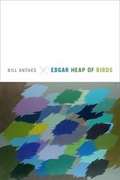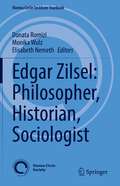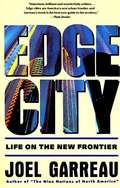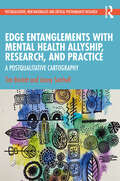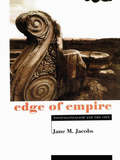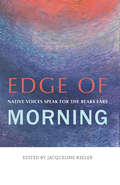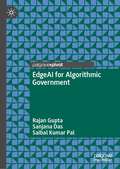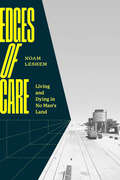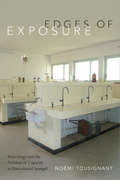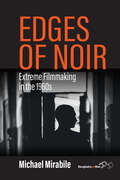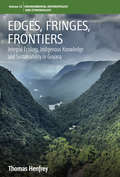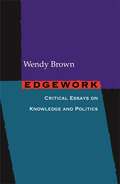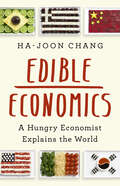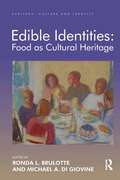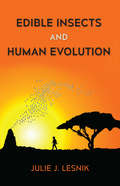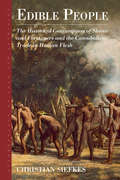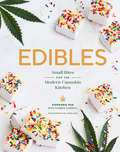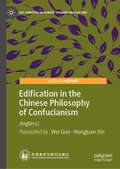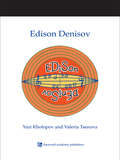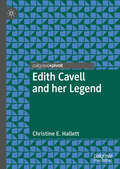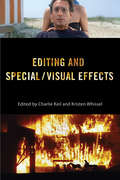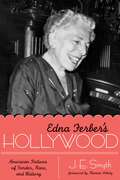- Table View
- List View
Edgar Heap of Birds
by Bill AnthesFor over three decades, contemporary Native American artist Hock E Aye Vi Edgar Heap of Birds has pursued a disciplined practice in multiple media, having shown his paintings, drawings, prints, and text-based conceptual art throughout numerous national and international galleries and public spaces. In the first book-length study of this important artist, Bill Anthes analyzes Heap of Birds's art and politics in relation to the international contemporary art scene, Native American history, and settler colonialism. Foregrounding how Heap of Birds roots his practice in Cheyenne spirituality and an indigenous way of seeing and being in the world, Anthes describes how Heap of Birds likens his art to "sharp rocks"--weapons delivering trenchant critiques of the loss of land, life, and autonomy endured by Native Americans. Whether appearing as interventions in public spaces or in a gallery, Heap of Birds's carefully honed artworks pose questions about time, modernity, identity, power, and the meaning and value of contemporary art in a global culture.
Edgar Zilsel: Philosopher, Historian, Sociologist (Vienna Circle Institute Yearbook #27)
by Elisabeth Nemeth Donata Romizi Monika WulzThis book provides a new all-round perspective on the life and work of Edgar Zilsel (1891-1944) as a philosopher, historian, and sociologist. He was close to the Vienna Circle and has been hitherto almost exclusively referred to in terms of the so-called “Zilsel thesis” on the origins of modern science. Much beyond this “thesis”, Zilsel’s brilliant work provides original insights on a broad number of topics, ranging from the philosophy of probability and statistics to the concept of “genius”, from the issues of scientific laws and theories to the sociological background of science and philosophy, and to the political analysis of the problems of his time. Praised by Herbert Feigl as an “outstanding brilliant mind”, Zilsel, being as a Social-Democrat of Jewish origins, mostly led a life of hardship marked by emigration and coming to a sudden and tragic end by suicide in 1944. The impossibility of an academic career has hindered the reception of Zilsel’s scientific work for a long time. This volume is a contribution to its late reception, providing new insights especially into his work during his years in Vienna; moreover, it shows the heuristic value of Zilsel’s ideas for future scholarly research – in philosophy, history, and sociology.
Edge City: Life on the New Frontier
by Joel GarreauFirst there was downtown. Then there were suburbs. Then there were malls. Then Americans launched the most sweeping change in 100 years in how they live, work, and play. The Edge City.From the Trade Paperback edition.
Edge Entanglements with Mental Health Allyship, Research, and Practice: A Postqualitative Cartography (Postqualitative, New Materialist and Critical Posthumanist Research)
by Tim Barlott Jenny SetchellEdge Entanglements traverses the borderlands of the community "mental health" sector by "plugging in" to concepts offered by Gilles Deleuze and Felix Guattari along with work from Mad Studies, postcolonial, and feminist scholars. Barlott and Setchell demonstrate what postqualitative inquiry can do, surfacing the transformative potential of freely-given relationships between psychiatrised people and allies in the community. Thinking with theory, the authors map the composition and generative processes of freely-given, ally relationships. Edge Entanglements surfaces how such relationships can unsettle constraints of the mental health sector and produce creative possibilities for psychiatrised people. Affectionately creating harmonies between theory and empirical "data," the authors sketch ally relationships in ways that move. Allyship is enacted through micropolitical processes of becoming-complicit: ongoing movement towards taking on the struggle of another as your own. Barlott and Setchell’s work offers both conceptual and practical insights into postqualitative experimentation, relationship-oriented mental health practice, and citizen activism that unsettles disciplinary boundaries. Ongoing, disruptive movements on the margins of the mental health sector – such as freely-given relationships – offer opportunities to be otherwise. Edge Entanglements is for people whose lives and practices are precariously interconnected with the mental health sector and are interested in doing things differently. This book is likely to be useful for novice and established (applied) new material and/or posthumanist scholars interested in postqualitative, theory-driven research; health practitioners seeking alternative or radical approaches to their work; and people interested in citizen advocacy, activism, and community organising in/out of the mental health sector.
Edge Seasons: A Mid-life Year
by Beth PowningFrom the bestselling, critically acclaimed author of The Hatbox Letters and Shadow Child comes the story of a year of transformation. In the middle years of her life, Beth Powning stands on a threshold: an &“edge season.&” Late one August, when Beth and her partner, Peter, observe the deserted sauna bath on their farm near Sussex, New Brunswick, she remembers the faith and energy that went into building it. As they begin to repair the sauna, the project becomes a metaphor for how dreams, relationships and commitments need to be continuously renewed. While their only child, Jake, prepares to leave for university, Beth and Peter contemplate changes of their own. As fall and winter gradually shut down the vibrant life of the gardens, fields and forests near her home, Beth witnesses the beauty and regenerative force of the natural world, weaving acutely observed descriptions of the countryside with the story of her own intimate transformation. Edge Seasons is an intensely absorbing journey that illuminates how change can shatter even as it strengthens.
Edge of Empire: Postcolonialism and the City
by Jane M. JacobsEdge of Empire examines struggles over urban space in three contemporary first world cities in an attempt to map the real geographies of colonialism and postcolonialism as manifest in modern society. From London, the one-time heart of the empire, to Perth and Brisbane, scenes of Aboriginal claims for the sacred in the space of the modern city, Jacobs emphasises the global geography of the local and unravels the spatialised cultural politics of postcolonial processes. Edge of Empire forms the basis for understanding imperialism over space and time, and is a recognition of the unruly spatial politics of race and nation, nature and culture, past and present.
Edge of Morning: Native Voices Speak for the Bears Ears
by Jacqueline KeelerIn support of tribal efforts to protect the Bears Ears, Native writers bear testimony to the fragile and essential nature of this sacred landscape in America’s remote red rock country. Through poem and essay, these often-ignored voices explore the ways many native people derive tradition, sustenance, and cultural history from the Bears Ears.
EdgeAI for Algorithmic Government
by Rajan Gupta Saibal Kumar Pal Sanjana DasThe book provides various EdgeAI concepts related to its architecture, key performance indicators, and enabling technologies after introducing algorithmic government, large-scale decision-making, and computing issues in the cloud and fog. With advancements in technology, artificial intelligence has permeated our personal lives and the fields of economy, socio-culture, and politics. The integration of artificial intelligence (AI) into decision-making for public services is changing how governments operate worldwide. This book discusses how algorithms help the government in various ways, including virtual assistants for busy civil servants, automated public services, and algorithmic decision-making processes. In such cases, the implementation of algorithms will occur on a massive scale and possibly affect the lives of entire communities. The cloud-centric architecture of artificial intelligence brings out challenges of latency, overhead communication, and significant privacy risks. Due to the sheer volume of data generated by IoT devices, the data analysis must be performed at the forefront of the network. This introduces the need for edge computing in algorithmic government. EdgeAI, the confluence of edge computing and AI, is the primary focus of this book. It also discusses how one can incorporate these concepts in algorithmic government through conceptual framework and decision points. Finally, the research work emphasizes some design challenges in edge computing from applications viewpoint. This book will be helpful for data engineers, data scientists, cloud engineers, data management experts, public policymakers, administrators, research scholars and academicians.
Edges of Care: Living and Dying in No Man’s Land
by Noam LeshemA firsthand look at the lives of those who reside in no man’s land—the violence they endure and their immense resilience. “No man’s land” invokes stretches of barren landscape, twisted barbed wire, desolation, and the devastation of war. But this is not always the reality. According to Noam Leshem in Edges of Care, the term also reveals radical abandonment by the state. From the Northern Sahara to the Amazon rainforests, people around the world find themselves in places that have been stripped of sovereign care. Leshem is committed to defining these spaces and providing a more intimate understanding of this urgent political reality. Based on nearly a decade of research in some of the world’s most challenging conflict zones, Edges of Care offers a profound account of abandoned lives and lands, and how they endure and sometimes thrive once left to fend for themselves. Leshem interrogates no man’s land as a site of radical uncaring: abandoned by a sovereign power in a relinquishment of responsibility for the space or anyone inside it. To understand the ramifications of such uncaring, Leshem takes readers through a diverse series of abandoned places, including areas in Palestine, Syria, Colombia, Sudan, and Cyprus. He shows that no man’s land is not empty of life, but almost always inhabited and, in fact, often generative of new modes of being. Beautifully written and evocative, Edges of Care reveals the unexamined complexities and political dynamics hidden within and around places governed by callous indifference.
Edges of Exposure: Toxicology and the Problem of Capacity in Postcolonial Senegal (Experimental Futures)
by Noémi TousignantIn the industrialized nations of the global North, well-funded agencies like the CDC attend to citizens' health, monitoring and treating for toxic poisons like lead. How do the under-resourced nations of the global South meet such challenges? <P><P> In Edges of Exposure, Noémi Tousignant traces the work of toxicologists in Senegal as they have sought to warn of and remediate the presence of heavy metals and other poisons in their communities. Situating recent toxic scandals within histories of science and regulation in postcolonial Africa, Tousignant shows how decolonization and structural adjustment have impacted toxicity and toxicology research. <P>Ultimately, as Tousignant reveals, scientists' capacity to conduct research—as determined by material working conditions, levels of public investment, and their creative but not always successful efforts to make visible the harm of toxic poisons—affects their ability to keep equipment, labs, projects, and careers going.
Edges of Noir: Extreme Filmmaking in the 1960s
by Michael MirabileEdges of Noir challenges the notion that noir film nearly vanished after 1958 until its subsequent “neo-noir” revival between 1973 and 1981. The 1960s, regardless of critical neglect, include some of the most provocative films of the post-World War II decades. Often formally disruptive and experimental, films including Shock Corridor (1963), Mirage (1965), The 3rd Voice (1960), and Point Blank (1967) evoke controversial issues of the era, deriving dynamic influences amongst exploitation cinema, sensationalistic American B movies, and the European New Wave movement. Whether the focus is on nuclear destruction, mind control, or surveillance, late noir films, above all else, vividly portray the collective fears from the time.
Edges, Fringes, Frontiers: Integral Ecology, Indigenous Knowledge and Sustainability in Guyana (Environmental Anthropology and Ethnobiology #23)
by Thomas HenfreyBased on an ethnographic account of subsistence use of Amazonian forests by Wapishana people in Guyana, Edges, Frontiers, Fringes examines the social, cultural and behavioral bases for sustainability and resilience in indigenous resource use. Developing an original framework for holistic analysis, it demonstrates that flexible interplay among multiple modes of environmental understanding and decision-making allows the Wapishana to navigate social-ecological complexity successfully in ways that reconcile short-term material needs with long-term maintenance and enhancement of the resource base.
Edgework: Critical Essays on Knowledge and Politics
by Wendy BrownEdgework brings together seven of Wendy Brown's most provocative recent essays in political and cultural theory. They range from explorations of politics post-9/11 to critical reflections on the academic norms governing feminist studies and political theory. Edgework is also concerned with the intellectual and political value of critique itself. It renders contemporary the ancient jurisprudential meaning of critique as krisis, in which a tear in the fabric of justice becomes the occasion of a public sifting or thoughtfulness, the development of criteria for judgment, and the inauguration of political renewal or restoration. Each essay probes a contemporary problem--the charge of being unpatriotic for dissenting from U.S. foreign policy, the erosion of liberal democracy by neoliberal political rationality, feminism's loss of a revolutionary horizon--and seeks to grasp the intellectual impasse the problem signals as well as the political incitement it may harbor.
Edible Economics: A Hungry Economist Explains the World
by Ha-Joon ChangEdible Economics brings the sort of creative fusion that spices up a great kitchen to the often too-disciplined subject of economics For decades, a single, free-market philosophy has dominated global economics. But this intellectual monoculture is bland and unhealthy. Bestselling author and economist Ha-Joon Chang makes challenging economic ideas delicious by plating them alongside stories about food from around the world, using the diverse histories behind familiar food items to explore economic theory. For Chang, chocolate is a lifelong addiction, but more exciting are the insights it offers into postindustrial knowledge economies; and while okra makes Southern gumbo heart-meltingly smooth, it also speaks of capitalism&’s entangled relationship with freedom. Myth-busting, witty, and thought-provoking, Edible Economics serves up a feast of bold ideas about globalization, climate change, immigration, austerity, automation, and why carrots need not be orange. It shows that getting to grips with the economy is like learning a recipe: when we understand it, we can adapt and improve it—and better understand our world.
Edible Identities: Food As Cultural Heritage (Heritage, Culture and Identity)
by Michael A. Di Giovine Ronda L. BrulotteFood - its cultivation, preparation and communal consumption - has long been considered a form of cultural heritage. A dynamic, living product, food creates social bonds as it simultaneously marks off and maintains cultural difference. In bringing together anthropologists, historians and other scholars of food and heritage, this volume closely examines the ways in which the cultivation, preparation, and consumption of food is used to create identity claims of 'cultural heritage' on local, regional, national and international scales. Contributors explore a range of themes, including how food is used to mark insiders and outsiders within an ethnic group; how the same food's meanings change within a particular society based on class, gender or taste; and how traditions are 'invented' for the revitalization of a community during periods of cultural pressure. Featuring case studies from Europe, Asia and the Americas, this timely volume also addresses the complex processes of classifying, designating, and valorizing food as 'terroir,' 'slow food,' or as intangible cultural heritage through UNESCO. By effectively analyzing food and foodways through the perspectives of critical heritage studies, this collection productively brings two overlapping but frequently separate theoretical frameworks into conversation.
Edible Insects and Human Evolution
by Julie J. LesnikResearchers who study ancient human diets tend to focus on meat eating because the practice of butchery is very apparent in the archaeological record. In this volume, Julie Lesnik highlights a different food source, tracing evidence that humans and their hominin ancestors also consumed insects throughout the entire course of human evolution. Lesnik combines primatology, sociocultural anthropology, reproductive physiology, and paleoanthropology to examine the role of insects in the diets of hunter-gatherers and our nonhuman primate cousins. She posits that women would likely spend more time foraging for and eating insects than men, arguing that this pattern is important to note because women are too often ignored in reconstructions of ancient human behavior. Because of the abundance of insects and the low risk of acquiring them, insects were a reliable food source that mothers used to feed their families over the past five million years. Although they are consumed worldwide to this day, insects are not usually considered food in Western societies. Tying together ancient history with our modern lives, Lesnik points out that insects are highly nutritious and a very sustainable protein alternative. She believes that if we accept that edible insects are a part of the human legacy, we may have new conversations about what is good to eat—both in past diets and for the future of food.
Edible People: The Historical Consumption of Slaves and Foreigners and the Cannibalistic Trade in Human Flesh (Anthropology of Food & Nutrition #11)
by Christian SiefkesWhile human cannibalism has attracted considerable notice and controversy, certain aspects of the practice have received scant attention. These include the connection between cannibalism and xenophobia: the capture and consumption of unwanted strangers. Likewise ignored is the connection to slavery: the fact that in some societies slaves and persons captured in slave raids could be, and were, killed and eaten. This book explores these largely forgotten practices and ignored connections while making explicit the links between cannibal acts, imperialist influences and the role of capitalist trading practices. These are highly important for the history of the slave trade and for understanding the colonialist history of Africa.
Edibles: Small Bites for the Modern Cannabis Kitchen
by Stephanie HuaBring a new herb into your kitchen with this tasty unique collection of recipes for bite-sized, low-dose sweet and savory cannabis edibles. This cookbook ventures boldly beyond pot brownies with delicious and unique baked confections as well as innovative savory treats. Designed for bakers and cooks of all skill levels, Edibles: Small Bites for the Modern Cannabis Kitchen includes simple recipes like spiced superfood truffles and roasted beet hummus, alongside more advanced recipes like artisanal marshmallows and Gruyére & green garlic gougéres—all brought to life with vibrant photography.Complete with instructions for creating master ingredients such as canna butters, oils, honey, and maple syrup, as well as information on dosage and portions and the science of cannabis, this cookbook slash baking book gives cannabis newbies and connoisseurs alike the info they need to create an easy, safe, and delicious edibles experience.• A DIY recipe book for beginner and advanced cannabis bakers• Contains detailed information on correct dosage and portions• Provides tips, tricks and tools of the tradeAuthor Stephanie Hua is the founder and chief confectioner of the popular gourmet edibles line, Mellows, and co-author Coreen Carroll is a winner on the Netflix television series Cooked with Cannabis, executive chef, and cofounder a dining pop-up, Cannaisseur Series, which hosts curated cannabis and culinary experiences, events, and workshops.Those who like The Easy Cannabis Cookbook: 60+ Medical Marijuana Recipes for Sweet and Savory Edibles, Bong Appétit: Mastering the Art of Cooking with Weed, and Marijuana Edibles: 40 Easy and Delicious Cannabis-Infused Desserts and other cannabis cookbooks will want to add Edibles to their collection.• Delightful addition to any foodie's book shelf• Thoughtful gift for anyone who enjoys cooking, baking, and eating edibles• Cannabis-curious cookbook collectors will appreciate these unique recipes
Edification in the Chinese Philosophy of Confucianism (Key Concepts in Chinese Thought and Culture)
by Jinglin LiThis pivot focuses on “the concept of edification” in a bid to systematically expound its connotative structure and logical evolution. It is divided into ten chapters, embracing various issues, such as human nature as the foundation of edification, the development of edification and cultivation, the evolution of edification and the resultant life based on ritual and music, the political orientation and ultimate care of edification, and the nurturing of social edification, in an effort to offer a panoramic view of the intellectual features of Confucianism, and consequently a profound reflection on the cultural consciousness of contemporary China. The book is expected to satisfy the needs for a better understanding of edification as a Confucian concept, and the conceptual features of Chinese philosophy, or rather, Confucianism.
Edison Denisov
by KholopovFirst published in 1997. Routledge is an imprint of Taylor & Francis, an informa company.
Edith Cavell and her Legend
by Christine E. HallettThis book examines the myriad identities and portrayals of Edith Cavell, as they have been constructed and handed down by propagandists, biographers and artists. Cavell was first introduced to the British public through a series of Foreign Office statements which claimed to establish the “facts” of her case. Her own voice, along with those of her family, colleagues and friends, were muted, as a monolithic image of a national heroine and martyr emerged. The book identifies two main areas of tension in her commemoration: firstly, the contrast between complexity of her own behaviour and motivations and the simplicity of the “Cavell Legend” that was constructed around her; and, secondly, the mismatch between the attempts of individuals and professional organisations to commemorate her life and work, and the public construction of a “heroine” who could be of value to the nation state.
Editing and Special/Visual Effects
by Kristen Whissel Dana Polan Ariel Rogers Scott Higgins Julie Turnock Tanine Allison Paul Monticone Dan North Professor Deron Overpeck Benjamin Wright Meraj Dhir Lisa Purse Professor Charlie KeilMost moviegoers think of editing and special effects as distinct components of the filmmaking process. We might even conceive of them as polar opposites, since effective film editing is often subtle and almost invisible, whereas special effects frequently call attention to themselves. Yet, film editors and visual effects artists have worked hand-in-hand from the dawn of cinema to the present day. Editing and Special/Visual Effects brings together a diverse range of film scholars who trace how the arts of editing and effects have evolved in tandem. Collectively, the contributors demonstrate how these two crafts have been integral to cinematic history, starting with the "trick films" of the early silent era, which astounded audiences by splicing in or editing out key frames, all the way up to cutting-edge effects technologies and concealed edits used to create the illusions. Throughout, readers learn about a variety of filmmaking techniques, from classic Hollywood's rear projection and matte shots to the fast cuts and wall-to-wall CGI of the contemporary blockbuster. In addition to providing a rich historical overview, Editing and Special/Visual Effects supplies multiple perspectives on these twinned crafts, introducing readers to the analog and digital tools used in each craft, showing the impact of changes in the film industry, and giving the reader a new appreciation for the processes of artistic collaboration they involve.
Editing the Image
by Catherine M. Soussloff Mark Cheetham Elizabeth LeggeThe editing process is a vital part of virtually every form of media. Primarily associated with texts and written language, editing is equally essential, if less examined, in regard to visual media. Editing the Image looks at the editing of visual media as both a series of technical exercises and as an allegory. It touches on concerns that are crucial to the history of art and visual culture, as well as those media and institutions that produce and disseminate the visual arts in our society.Featuring contributors from a wide range of disciplines, Editing the Image considers editing in the context of academic journals, art-historical texts, illustrated books, museum displays, and exhibitions. It is an inclusive analysis of visual forms commonly associated with the process of editing - photography, film, and video - as well as some that are not intrinsically linked to editing - painting, sculpture, and architecture. In addition to wide-ranging academic considerations, this collection includes discussions of moving picture media and studio art by practitioners, giving the study a practical focus. For anyone who has considered the implications of the editorial process, this work will be of significant interest.
Editors, Scholars, and the Social Text
by Darcy CullenAn academic book is much more than paper and ink, pixels and electrons. A dynamic social network of authors, editors, typesetters, proofreaders, indexers, printers, and marketers must work together to turn a manuscript into a book.Editors, Scholars, and the Social Text explores the theories and practices of editing, the processes of production and reproduction, and the relationships between authors and texts, as well as manuscripts and books. By bringing together academic experts and experienced practitioners, including editorial specialists, scholarly publishing professionals, and designers, Editors, Scholars, and the Social Text offers indispensable insight into the past and future of academic communication.
Edna Ferber's Hollywood: American Fictions of Gender, Race, and History (Texas Film and Media Studies Series)
by J. E. SmythEdna Ferber’s Hollywood reveals one of the most influential artistic relationships of the twentieth century—the four-decade partnership between historical novelist Edna Ferber and the Hollywood studios. Ferber was one of America’s most controversial popular historians, a writer whose uniquely feminist, multiracial view of the national past deliberately clashed with traditional narratives of white masculine power. Hollywood paid premium sums to adapt her novels, creating some of the most memorable films of the studio era—among them Show Boat, Cimarron, and Giant. Her historical fiction resonated with Hollywood’s interest in prestigious historical filmmaking aimed principally, but not exclusively, at female audiences. In Edna Ferber’s Hollywood, J. E. Smyth explores the research, writing, marketing, reception, and production histories of Hollywood’s Ferber franchise. Smyth tracks Ferber’s working relationships with Samuel Goldwyn, Leland Hayward, George Stevens, and James Dean; her landmark contract negotiations with Warner Bros.; and the controversies surrounding Giant’s critique of Jim-Crow Texas. But Edna Ferber’s Hollywood is also the study of the historical vision of an American outsider—a woman, a Jew, a novelist with few literary pretensions, an unashamed middlebrow who challenged the prescribed boundaries among gender, race, history, and fiction. In a masterful film and literary history, Smyth explores how Ferber’s work helped shape Hollywood’s attitude toward the American past.
